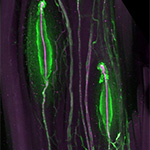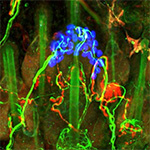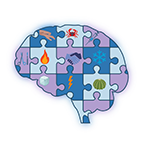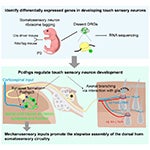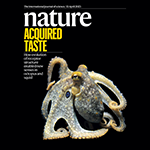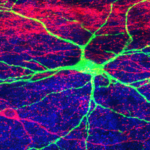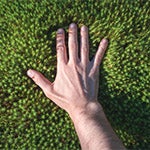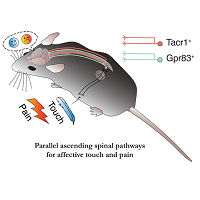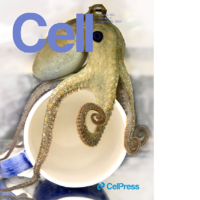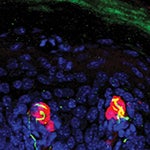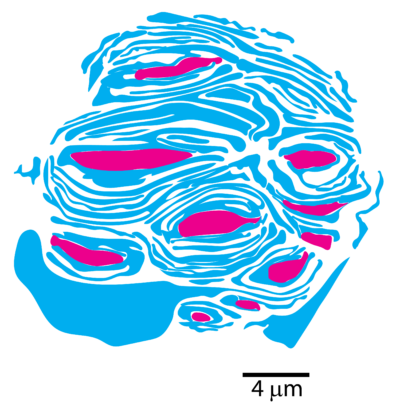Neuro Topics - Touch
SEARCH OTHER RESEARCH AREAS
November 4, 2024
How often do we sense vibration? More than you might think. New work from Josef Turecek & David Ginty reveals how mechanosensory neurons are activated during movement and exploration.
Original article in: Neuron >
July 3, 2024
Until relatively recently, research on touch has lagged behind other senses like hearing and vision. However, new research tools and greater scientific appreciation has led to a "touch renaissance". David Ginty, April Levin, and Lauren Orefice discuss current research on touch, it's role in development, and potential therapies to help those suffering from touch dysfunction.
May 9, 2024
We know that the cerebral cortex is vital for the perception of our somatosensory environment. Yet much remains mysterious. How do we know when something is too hot and what sets that thermostat? Daniel G. Taub and Clifford J. Woolf explain how a specific region called the secondary somatosensory cortex can alter our somatosensory sensitivity.
Original article in: Nature Communications >
September 13, 2023
HMS News article on new research from David Ginty and colleagues, first author Charalampia Koutsioumpa. Studying mice, they found that sensory neurons develop customized nerve endings based on cues from the skin.
Original article in: Developmental Cell >
May 5, 2023
Shan Meltzer and Emmanuella Asante share new research from the Ginty lab showing that the clustered protocadherin gamma (Pcdhg) gene locus regulates somatosensory neuron synapse formation, mechanosensory neuron branching patterns, and circuit assembly in the mechanosensory dorsal horn.
Original article in: Cell >
April 20, 2023
The lab of Nick Bellono, along with colleagues at UC San Diego and UT Southwestern Medical Center, recently published two papers in Nature describing the path of divergent sensing capabilities in cephalopods by tracking their evolutionary lineage from common ancestral neurons.
Original article in: Nature >
December 8, 2022
HMS News article on two new research papers from David Ginty, Chris Harvey, and colleagues, first authors Josef Turecek, Anda Chirila, and Genelle Rankin, suggesting the spinal cord and brainstem are essential for processing touch signals as they travel to the brain.
Original article in: Cell >
November 28, 2022
Round up of awards and honors earned by the HBI Community
October 26, 2021
Round up of awards and honors earned by the HBI community.
October 26, 2021
HMS News article on new research from the labs of David Ginty and Christopher Harvey, with first authors Brendan P. Lehnert and Celine Santiago, that reveals mechanisms that may underlie the greater sensitivity of certain skin regions.
Original article in: Cell >
November 13, 2020
Seungwon (Sebastian) Choi shares new research from the labs of David Ginty and colleagues at the University of Pittsburgh. They applied new mouse genetic tools in conjunction with anatomical, physiological and behavioral approaches to better understand the functional organization of ascending touch, thermal and pain pathways.
Original article in: Nature >
November 2, 2020
MCB News piece on new research from the Bellono lab, first author Lena van Giesen, uncovering the molecular basis of chemotactile sensation in octopuses.
Original article in: Cell >
September 23, 2020
Round up of awards and honors earned by the HBI community.
September 23, 2020
Harvard Medicine Magazine article showcasing many beautiful images taken by members of the lab of David Ginty at HMS showing cutaneous sensory neurons in action.
Original article in: Harvard Medicine Magazine >
September 22, 2020
Corey Harwell was interviewed for a SFN Neuronline feature on diversifying the field through mentorship and scientific exposure.
July 9, 2020
A new study from the labs of David Ginty, Jan Drugowitsch, Christopher Harvey, & Wade Regehr (co-first authors Nicole Neubarth, Alan Emanuel, & Yin Liu) used mouse genetic tools to gain new insights into the anatomy & function of Meissner corpuscles.
Original article in: Science >
August 8, 2019
New research points to potential therapy for abnormal touch sensitivity in autism spectrum disorders.

